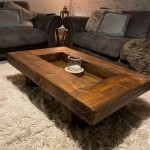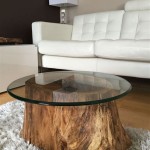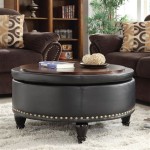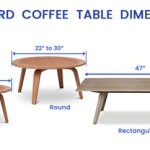Mid-Century Modern Coffee Tables: A Timeless Fusion of Form and Function
Mid-Century Modern design, a movement that flourished roughly from the mid-1940s to the late 1960s, continues to exert a significant influence on contemporary aesthetics. Its enduring appeal stems from its emphasis on clean lines, organic shapes, and a focus on functionality. Within this design paradigm, the coffee table occupies a central position, serving as both a practical surface and a defining element of the living space. Mid-Century Modern coffee tables are characterized by their understated elegance, innovative use of materials, and a seamless integration of form and function. They represent a departure from the ornate and heavily decorated styles of previous eras, embracing simplicity and practicality as guiding principles.
The design philosophy behind Mid-Century Modern coffee tables is rooted in a desire to create objects that are both visually appealing and highly functional. This approach often resulted in pieces that were lightweight, easy to move, and adaptable to a variety of living spaces. The emphasis on functionality did not, however, preclude artistic expression. Designers skillfully incorporated visual interest through the use of contrasting materials, geometric patterns, and subtle curves, ensuring that these tables were not merely utilitarian objects but also works of art in their own right.
Key Characteristics of Mid-Century Modern Coffee Tables
Several defining characteristics distinguish Mid-Century Modern coffee tables from other furniture styles. Understanding these characteristics is essential for identifying and appreciating the unique qualities of these iconic pieces.
Clean Lines and Geometric Shapes: One of the most recognizable features of Mid-Century Modern design is its emphasis on clean, uncluttered lines. Coffee tables from this era typically feature simple geometric forms, such as rectangles, squares, circles, and ovals. These shapes are often combined in harmonious ways, creating pieces that are both visually striking and aesthetically balanced. The absence of excessive ornamentation allows the inherent beauty of the materials to shine through.
Emphasis on Natural Materials: Mid-Century Modern designers frequently utilized natural materials, such as wood, glass, and metal, in their coffee table designs. Wood, particularly teak, walnut, and birch, was highly prized for its warm tones and natural grain patterns. Glass tops were often incorporated to create a sense of lightness and transparency, while metal legs and frames provided structural support and a touch of industrial chic. The combination of these materials resulted in pieces that were both durable and visually appealing.
Focus on Functionality: Mid-Century Modern coffee tables were designed with practicality in mind. Many tables featured built-in storage compartments, such as drawers or shelves, to help keep living spaces organized. Others were designed to be easily moved or reconfigured, allowing for flexibility in interior design. The emphasis on functionality did not, however, detract from the aesthetic appeal of these pieces. Designers cleverly integrated practical features into the overall design, ensuring that they were both functional and visually harmonious.
Popular Materials Used in Mid-Century Modern Coffee Tables
The selection of materials played a crucial role in defining the aesthetic and durability of Mid-Century Modern coffee tables. Certain materials were favored for their unique properties and ability to complement the clean, minimalist design aesthetic.
Teak: Teak, a dense and durable hardwood, was a popular choice for Mid-Century Modern furniture, including coffee tables. Its rich, warm color and natural resistance to moisture made it ideal for creating pieces that were both beautiful and long-lasting. Teak coffee tables often featured clean lines and simple geometric shapes, showcasing the natural beauty of the wood grain. Its ability to withstand the test of time and resist wear and tear contributes to its enduring popularity.
Walnut: Walnut, another prized hardwood, was also frequently used in Mid-Century Modern coffee table designs. Its darker, more sophisticated color and intricate grain patterns lent a touch of elegance to these pieces. Walnut coffee tables often featured more elaborate designs than their teak counterparts, with sculpted legs, rounded edges, and intricate detailing. The inherent beauty and luxurious feel of walnut made it a popular choice for creating high-end Mid-Century Modern furniture.
Glass: Glass tops were a common feature of Mid-Century Modern coffee tables, particularly those designed in the later years of the movement. Glass offered a sense of lightness and transparency, allowing the base of the table to be fully visible. This was particularly effective when the base was made of metal or featured an interesting geometric design. Glass tops also provided a smooth, easy-to-clean surface, making them a practical choice for everyday use. The combination of glass and wood or metal created a visually striking contrast and contributed to the overall aesthetic appeal of these tables.
Metal: Metal, often used in the form of chrome or steel, played a significant role in Mid-Century Modern coffee table designs. Metal legs and frames provided structural support and a touch of industrial chic. Metal was often used in combination with wood or glass, creating a visually interesting contrast. The sleek, minimalist look of metal complemented the clean lines and geometric shapes that were characteristic of Mid-Century Modern design. The durability and versatility of metal made it a practical choice for creating long-lasting and stylish coffee tables.
Iconic Mid-Century Modern Coffee Table Designs
Several iconic coffee table designs have become synonymous with the Mid-Century Modern movement. These pieces represent the pinnacle of design innovation and continue to inspire contemporary furniture designers.
The Noguchi Table: Designed by Isamu Noguchi in 1947, the Noguchi Table is perhaps the most recognizable Mid-Century Modern coffee table. Its simple yet elegant design consists of a freeform glass top supported by two interlocking wooden legs. The table is a testament to Noguchi's artistic vision and his ability to create functional objects that are also works of art. The Noguchi Table remains a popular choice for those seeking a timeless and sophisticated addition to their living space.
The Eames Coffee Table: Designed by Charles and Ray Eames in the 1940s, the Eames Coffee Table is a versatile and practical piece that embodies the spirit of Mid-Century Modern design. The table features a simple rectangular or round top made of laminate or wood, supported by a metal base. The Eames Coffee Table is available in a variety of sizes and finishes, making it suitable for a wide range of living spaces. Its clean lines and understated elegance have made it a perennial favorite among design enthusiasts.
The George Nelson Basic Coffee Table: Designed by George Nelson in the 1950s, the Basic Coffee Table is known for its clean lines and functionality. Characterized by a simple rectangular or square top and slender, tapered legs, this table embodies the understated elegance of the Mid-Century Modern aesthetic. The use of diverse materials like wood, laminate, and metal for the legs underscores the table's versatility, making it a suitable choice for a variety of interior decor styles.
Danish Modern Coffee Tables: Characterized by clean lines, organic shapes, and a focus on functionality, Danish Modern coffee tables are a staple of the Mid-Century Modern movement. Often crafted from high-quality hardwoods like teak and rosewood, these tables showcase the natural beauty of the wood grain. The designs typically feature simple, elegant profiles with tapered legs and subtle curves, reflecting the Scandinavian emphasis on simplicity and craftsmanship. Danish Modern coffee tables are valued for their timeless appeal and ability to seamlessly blend into various interior styles.
These iconic designs, among others, continue to influence contemporary furniture design and demonstrate the enduring appeal of Mid-Century Modern aesthetics. Their emphasis on clean lines, functionality, and the use of natural materials has cemented their place in design history.
The enduring popularity of Mid-Century Modern coffee tables can be attributed to their timeless design, versatility, and ability to complement a wide range of interior styles. Whether used as a focal point in a living room or as a functional surface in a smaller space, these tables offer a unique blend of form and function that continues to resonate with design enthusiasts today. Their understated elegance and emphasis on practicality make them a valuable addition to any home.

Mid Century Modern Coffee Table Signature Boutique Event Als Maui Hawaii

Maddox Mid Century Modern Nesting Coffee Table Set Tables

Mid Century Pop Up Coffee Table Modern Living Room Furniture West Elm

25 Best Mid Century Modern Style Coffee Table For You Adria

Mid Century Modern Coffee Table Handmade Wood

Mid Century Storage Coffee Table Modern Living Room Furniture With

Mid Century Modern Coffee Table Handmade Wood

Noak Mid Century Solid Wood Coffee Table Midinmod Tx

Cascade Mid Century Coffee Table Walnut And Oak

Mid Century Modern Oval Coffee Table With Slatted Shelf Tusk And Tail Design







